The steps on how to write a nonfiction book are easy to follow, but can be difficult to execute if you don't have a clear plan.
Many first time authors experience information overload when it comes to writing a nonfiction book. Where do I start? How do I build authority? What chapters do I need to include? Do I know enough about this topic?
If you're mind is racing with questions about how to get started with your book, then you’ve landed in the right place!
Writing a book can be a grueling, lengthy process. But with a strategic system in place, you could become a nonfiction book author within three to four months.
However, you need an extremely high level of motivation and dedication, as well as a clear, proven system to follow.
In this article, we’ll cover all there is to know about the nonfiction book writing process.
How to write a nonfiction book
Writing a nonfiction book is one of the most challenging paths you will ever take. But it can also be one of the most rewarding accomplishments of your life.
Before we get started with the steps to write a nonfiction book, let's review some foundational questions that many aspiring authors have.
What is a nonfiction book?
A nonfiction book is based on facts, such as real events, people, and places. It is a broad category, and includes topics such as biography, memoir, business, health, religion, self-help, science, cooking, and more.
A nonfiction book differs from a fiction book in the sense that it is real, not imaginary.
The purpose of nonfiction books is commonly to educate or inform the reader, whereas the purpose of fiction books is typically to entertain.
Perennial nonfiction books are titles such as How to Win Friends and Influence People from Dale Carnegie, A Brief History of Time by Stephen Hawking, and Anne Frank's The Diary of a Young Girl.
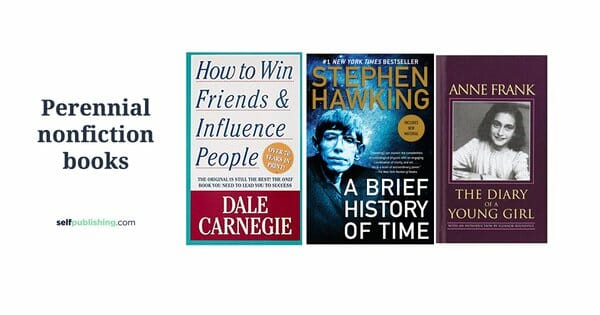
What is the author’s purpose in a work of nonfiction?
In a nonfiction book, the author’s main purpose or reason for writing on the topic is to inform or educate readers about a certain topic.
While there are some nonfiction books that also entertain readers, the most common author's purpose in a work of nonfiction is to raise awareness about a certain topic, event, or concept.
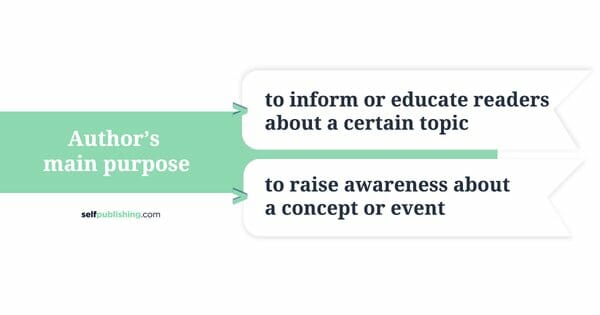
How many words are in a nonfiction book?
Because nonfiction is such a broad category, it really depends on the type of nonfiction you are writing, but generally a nonfiction book should be about 40,000 words.
To determine how many words in a novel, narrow down your topic and do some research to see what the average word count is.
Use this Word & Page Count Calculator to calculate how many words you should aim for, based on your genre and audience.
How long does it take to write a nonfiction book?
It can take anywhere from three months to several years to write a nonfiction book, depending on the author's speed, research process, book length, and other variables.
On average, it can take a self-published author typically six months to one year to write their nonfiction book. However, that means the author is setting time aside daily to work on their book, staying focused, and motivated.
Other nonfiction authors, especially those with heavy research an in–depth analysis can take much longer. How long it takes to write a nonfiction book really just depends on several factors.
Benefits of writing a nonfiction book
Making a decision to write a book could change your life. Just think about all the ways you could leverage your expertise!
If you’re interested in how to write a book, it’s important to understand all the things writing the book can do for you, so that you can stay motivated throughout the process.
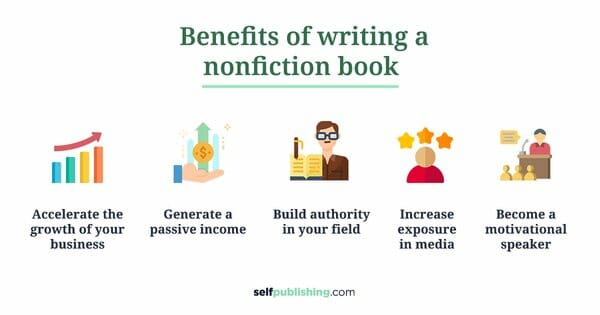
Some rewarding results that can come after you write a nonfiction book are:
- Exponentially accelerate the growth of your business
- Generate a stream of passive income for years to come
- Build authority in your field of expertise
- Increase exposure in the media
- Become a motivational speaker
- …and so much more (this is just the beginning)!
Imagine for a moment…walking into your local bookstore and seeing your book placed at the front of the store in the new releases section. Or browsing on Amazon KDP, the world’s largest online bookstore, and seeing your nonfiction book listed as a bestseller alongside well-known authors.
It can happen in as little as three months if you are fully committed and ready to start today.

How to Write a Nonfiction Book in 21 Steps
You're clear on the type of nonfiction book you want to write, and you're ready to get started.
Before you start writing, it's time to lay the groundwork and get clear on the entire process. This will help you manage your book writing expectations, and prepare for the nonfiction book writing journey that lies ahead.
With those foundational questions out of the way, let’s move on to 21-step checklist so you can start learning exactly how to write a nonfiction book.
#1— Develop the mindset to learn how to write a nonfiction book
The first step in how to become an author is to develop a rock solid author mindset. Without a writer’s mindset, you are going to struggle to get anywhere with your book. Writing has more to do with your attitude towards the craft than the skill required to get you there.
If writing words down and tying sentences together to craft a story is the skill, your mindset is the foundation that keeps this motivation moving forward.
Identifying yourself as a writer from the start (even if you haven't published yet) will form the mindset needed to continue working on your book.
To succeed, you must toughen up so that nothing gets in your way of writing.
This is also known as imposter syndrome: A psychological pattern where a person doubts their accomplishments and has an ongoing internalized fear of being exposed as a fraud.
Here’s how to prevent imposter syndrome as an aspiring author:
- Define what it means to be an author or writer. Is this someone who wakes up at 5am and writes 1000 words a day?
- Tell yourself you’re a writer. Just do it. It feels strange at first but you will begin to believe your own self-talk.
- Talk about your book idea. That’s right – start telling people you are writing a book. Many writers working on a book will keep it a secret until published. Even then, they might not about it.
- Take action to build author confidence. Imposter syndrome paralyzes you. Focus on increasing your author confidence and getting rid of doubt. This can be done by committing to writing every day. Just 500 words is enough. Build that writing habits early and you’ll be walking and talking like a true author.
#2 – Create a Book Writing Plan
Excuses will kill your chances of becoming a published author. There are no good reasons for not writing a book, only good excuses you convince yourself are real.
You are trying to protect yourself from embarrassment, only to create a new kind of shame: the shame of not finishing the book you have been talking about for years.
Some of the most common excuses that hold writers back are: There is no time to write in my life right now. I can't get past my distractions. I can never be as good as my favorite famous author. My book has to perfect.
Excuses are easy to dish out. But identifying them for what they are (excuses), is the first step towards taking action and changing your limiting mindset.
Excuses, while they may seem valid, are walls of fear. Banish your excuses right now and commit to writing your book.
Here's how to overcome the excuses that prevent you from writing:
- Make the time to write. Set up a thirty-minute time block every day. Commit to writing during this time.
- Turn off your distractions. Get rid of the WiFi for an hour. Close the door. It is just you and the story.
- Be aware of comparisons to other writers. They worked hard to get where they are, and you will get there, too.
- Give yourself permission to write badly. It won’t be perfect, but a book that is half-finished can’t be published.
#3 – Identify your WHY
Start with this question: “Why am I doing this?”
Know your why. This is critical to moving ahead with your book idea. We usually have an intrinsic and extrinsic reason for wanting to learn how to write a nonfiction book.
Intrinsic Why: What is your #1 reason for wanting to write this book? Is it a bucket list goal you must achieve? Is it to help people overcome a root issue in their lives? Do you want to create a movement and generate social impact?
Extrinsic Why: Do you want to create a business from your book? Have passive income coming in for many years later? Become a full-time author and work from home? Grow your network? Build an online presence?
Getting super clear on why you want to write a bestselling book is the momentum to propel you forward and deliver your story. Enlisting the help of a book writing coach (like we offer here at SelfPublishing!) can also help you stay close to your why. This person will be your sounding board, motivation, and voice of reason during the writing process – providing much-needed support from someone who's published multiple books before.
#4 – Research nonfiction book topics
Whether you have a clear idea of what you want to write about or if you are still exploring possible topic ideas, it's important to do a bit of market research.
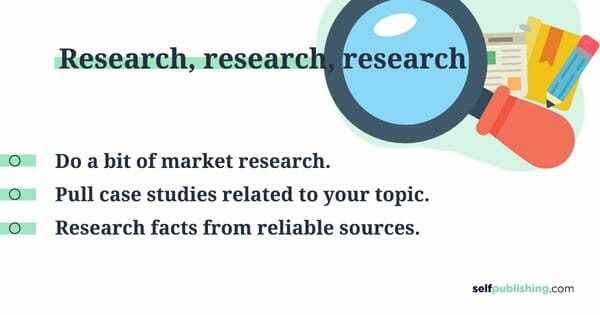
Researching the current news and case studies related to your potential topic are powerful ways to add credibility to your nonfiction book, and will help you develop your own ideas.
This adds greater depth to your nonfiction book, builds better trust with readers, and delivers content that exceeds customer expectations.
If you need help narrowing down your book idea, try experimenting with some writing prompts based on the genre you're interested in!
Here's how to write a nonfiction book that's well-researched:
- Use case studies. Pull case studies and make reference to the research. If there are not any case studies related to your topic, explore the idea of creating your own case study.
- Read books related to your topic. Mention good books or articles to support your material.
- Research facts from reliable sources. Post proven facts and figures from reliable sources such as scholarly journals, academic papers, white papers, newspapers, and more.
#5 – Select a nonfiction book topic
What are you writing about? It starts with having a deep interest and passion for the area you are focused on.
Common topics to write a nonfiction book on are:
- Business and Money
- Health, dieting and exercise
- Religion and Spirituality
- Self-Help
- Travel
- Philosophy
- Home repair
- Innovation and entrepreneurship
You probably already know this so it should be easy. Make a note of the area you are writing your book on. And then…
#6 — Drill down into your book idea
Everyone starts at the same place. It begins with an idea for the book.
What is the core idea for your book? If your nonfiction book topic is on health and dieting, your idea might be a book on “How to lose 7 pounds in your first month.”
Your book is going to be centered around this core idea.
You could have several ideas for the overall book but, to avoid writing a large, general book that nobody will read, make it more specific.
#7 — Schedule writing time
What gets scheduled, gets done. That’s right, you should schedule in your writing time just like any other appointment on your calendar.
Your writing routine will have a large role to play when it comes to writing and finishing your book.
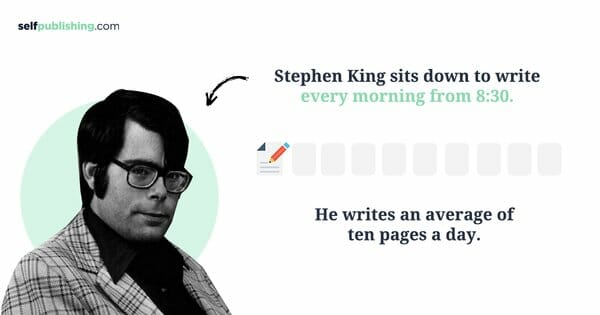
Scheduling time for writing, and sticking to it, will help you knock out your writing goals with ease.
Stephen King sits down to write every morning from eight-thirty. It was his way of programming his brain to get ready for the day’s work. He writes an average of ten pages a day.
W.H. Auden would rise at six a.m. and would work hard from seven to eleven-thirty, when his mind was sharpest.
When do you feel the most productive? If you can, make time for writing at the same time every day to set the tone for your writing productivity.

Commit to a time of day and a length of time during which to write. Set a goal for yourself and try to hit the target every day by sticking with your routine.
#8 — Establish a writing space
You need a place to write, and you must establish that space where you can write everyday, distraction-free for several hours a day.
Your writing environment plays a critical role in your life as an author. If you write in a place that’s full of noise, uncomfortable to be in, or affects your emotional state to the point you don’t want to do anything, you might consider your environment needs some work.

Here is how to create a writing space that inspires you to write:
Display your favorite author photos
Find at least twenty photos of authors you want to emulate. Print these out if you can and place them around your room. An alternative idea is to use the photos as screensavers or a desktop screen. You can change the photo every day if you like. There is nothing like writing and having your favorite author looking back at you as if to say, “Come on, you’ve got this!”
Hang up a yearly calendar
Your nonfiction book will get written faster if you have goals for each day and week. The best way to manage this is by scheduling your time on a calendar. Schedule every hour that you commit to your author business.
As Bob Goff said, “The battle for happiness begins on the pages of our calendars.”
Buy a big wall calendar. Have enough space on each day that you can write down your goals for that day. When you have a goal for that day or week, write it down or use a sticky note.
Create a clutter-free environment
If there is any one factor that will slow you down or kill your motivation, it is a room full of clutter.
If your room looks like a tornado swept through, it can have a serious impact on your emotional state. What you see around you also occupies space in your mind. Unfinished business is unconsciously recorded in your mind and this leads to clutter (both physical and mental).
Although you can’t always be in complete control of your physical space, you can get rid of any clutter you have control over. Go for a simple workplace that makes you feel relaxed.
Choose a writing surface and chair
Consider a standing desk, which is becoming popular for many reasons. Sitting down for long periods of time becomes uncomfortable and unhealthy. You can balance your online time between sitting and standing.
For sitting, you want a chair that is comfortable, but not too comfortable. Invest in a chair that requires you to sit up straight. If there is a comfortable back attached, as with most chairs, you have a tendency to get sleepy. This can trigger other habits as well, such as craving television.
Seek out the place where you can be at your most productive and feel confident and comfortable.
#9 — Choose a nonfiction book writing software
This is one of the most important writing tools you will choose. Your writing software needs to be efficient, easy to use and stress-free. Anything that requires a lot of formatting or a steep learning curve could end up costing you time and patience.
There are literally dozens of choices for book writing software, so it's really just a matter of finding what works best for you.

Here are 3 writing software for new authors to consider:
- Microsoft Word. Before any other writing tools came along, Microsoft Word was the only option available. Today, even though there are many other word processors out there, millions of people continue to use it for their writing needs. And it’s easy to see why. It’s trusted, reliable, and gets the job done well.
- Google Docs. It's a stripped-down version of Word that you can only use online. Some perks are that it comes with the built-in ability to share content, files, and documents with your team. You can easily communicate via comments for collaboration. If you write your book in Google Docs, you can share the link with anyone and they can edit, or make any changes right in the document itself. And all changes are trackable!
- Scrivener. A lot of writers absolutely love this program, with its advanced features and distraction-free writing experience. Scrivener was designed for writers; it’s super easy to lay out scenes, move content around, and outline your story, article, or manuscript. If you’re serious about learning how to write a nonfiction book, then putting in the time to learn this writing tool will definitely be worth it.
There are many forms of writing software that all have advantages to using them, but once you find what works for you, stick with it.
#10 — Create your mind map
A mind map is a brain dump of all your ideas. Using your theme and core idea as a basic starting point, your mind map will help you to visually organize everything into a structure for the book.
I highly recommend using pen and paper for this. You will enjoy the creative flow of this process with a physical version of the map rather than mind mapping software. But, if you prefer using an app to create your mindmap, you can try MindMeister.
Here is how to create your mind map:
- Start with your central idea. Write this idea in the center of the map.
- Add branches connecting key ideas that flow out from the core idea.
- Add keywords that tie these key ideas together.
- Using color coded markers or sticky notes, and identify the chapters within your mindmap.
- Take your chapter headings and…
#11 — How to write a nonfiction book outline
Now that your book topic is decided on, and you have mind mapped your ideas, it’s time to start determining how to outline a nonfiction book.
There are several ways to create a book outline, and it really boils down to author preference and style.
Here's how to write a nonfiction book outline:
- Use this Book Outline Generator for a helpful template to follow for your own outline.
- Map out your book's topics with a mindmap or bubble map, then organize similar concepts together into chapters.
- Answer the 5 Ws: Who, What, When, Where, Why.
- Use book writing software outline tools, like Scrivener's corkboard method.

What is a nonfiction book outline?
A book outline is a roadmap or blueprint for your story. It tells you where you need to go and when in chronological order.
Take the common themes of your chapters and, if applicable, divide your chapters into sections. This is your smooth transition from tangled mind map to organized outline.
Note that not every book needs sections; you might have chapters only. But if your chapters can be grouped into 3-6 different themes within the book, create a section for those common-themed chapters and group them together into a section.
The outline needs to be easy to follow and generally no more than a couple pages long.
The goal here is to take your mind map and consolidate your ideas into a structure that makes logical sense. This will be an incredible roadmap to follow when you are writing the book.
No outline = writing chaos.
There are two types of book outlines I will introduce here:
Option 1: Simple Nonfiction Book Outline
A simple book outline is just like it sounds; keep it basic and brief. Start with the title, then add in your major sections in the order that makes sense for your topic.
Don’t get too hung up on the perfect title at this stage of the process; you just want to come up with a good-for-now placeholder.
Use our Nonfiction Book Title Generator for ideas.
Option 2: Chapter-by-Chapter Nonfiction Book Outline
Your chapter-by-chapter book outline is a pumped-up version of the simple book outline.
To get started, first create a complete chapter list. With each chapter listed as a heading, you’ll later add material or move chapters around as the draft takes shape.
Create a working title for each chapter. List them in a logical order. After that, you’ll fill in the key points of each chapter.
Create a mind map for each chapter to outline a nonfiction book
Now that you have a list of your chapters, take each one and, similar to what you did with your main mind map for the book, apply this same technique to each chapter.
You want to mind map 3-7 ideas to cover in each chapter. These points will become the subtopics of each chapter that functions to make up chapter structure in your nonfiction book.
It is important to not get hung up on the small details of the chapter content at this stage. Simply make a list of your potential chapters. The outline will most likely change as you write the book. You can tweak the details as you go.
#12 — Determine your point of view
The language can be less formal if you are learning how to write a self-help book or another similar nonfiction book. This is because you are teaching a topic based on your own perspective and not necessarily on something based in scientific research.
Discovering your voice and writing style is as easy as being yourself, but it’s also a tough challenge.
Books that have a more conversational tone to them are just as credible as books with more profound language. You just have to keep your intended audience in mind when deciding what kind of tone you want to have in your book.
The easiest way to do this is to simply write as you would talk, as if you were explaining your topic to someone in front of you – maybe a friend.
Your reader will love this because it will feel like you are sitting with them, having a cup of coffee, hanging out and chatting about your favorite topic.

#13 — Write your first chapter
As soon as you have your nonfiction book outline ready, you want to build momentum right away. The best way to start this is to dive right into your first chapter.
You can start anywhere you like. You don’t have to start writing your nonfiction book in chronological order.
Take a chapter and, if you haven’t yet done so, spend a few minutes to brainstorm the main speaking points. These points are to be your chapter subheadings.
You already have the best software for writing, you’re all set in your writing environment, now you can start writing.
But wait…feeling stuck already?
That’s okay. You might want to start off with some free flow writing. Take a blank page and just start writing down your thoughts. Don’t think about what you are writing or if it makes any sense. This technique is designed to open up your mind to the flow of writing, or stream of consciousness
Write for 10-15 minutes until you are warmed up.
Next, dive into your chapter content.
#14 — Write a nonfiction book first draft
The major step in how to write a nonfiction book is – well, to actually write the first draft!
In this step, you are going to write the first draft of your book. All of it. Notice we did not say you were going to write and edit. No, you are only writing.
Do not edit while you write, and if you can fight temptation, do not read what you’ve written until the first draft is complete.
This seems like a long stretch, to write a 30-40,000-word book without reading it over, but…it’s important to tap into your creative mind and stay there during the writing phase.
It is difficult to access both your writing brain and editing brain at the same time. By sticking with the process of “write first, edit later,” you will finish your first draft faster and feel confident moving into the self-editing phase.
To learn how to write a nonfiction book, use this format:
- Mind map your chapter —10 minutes
- Outline/chapter subheadings—10 minutes
- Research [keep it light]—20 Minutes
- Write content—90 minutes
After you're done with your rough draft (first draft) you'll move on to the second draft/rewrite of your book when you will improve the organization, add more details, and create a polished draft before sending the manuscript to the editor.
#15 — Destroy writer’s block
At some point along the writer’s journey, you are going to get stuck. It is inevitable.
It is what we call the “messy middle” and, regardless you are writing fiction or nonfiction, it happens to everyone. You were feeling super-pumped to get this book written but halfway through, it begins to feel like an insurmountable mountain that you’ll never conquer.
Writer’s block is what happens when you hit a wall and struggle to move forward.
Here is what you can do when you find yourself being pulled down that dark hole.
Talk back to the voices trying to overpower your mind. Your internal critic is empowered when you believe what you are listening to is true.
Bring in the writer who has brought you this far – the one who took the initiative to learn how to write a nonfiction book. Be the writer that embraces fear and laughs at perfectionistic tendencies. Be that person that writes something even if it doesn’t sound good. Let yourself make mistakes and give yourself permission to fail.
Use positive affirmations are therapy for removing internal criticism.
Defeat the self-doubt by not owning it. Your fears exist in your mind. The book you are writing is great, and it will be finished.
Now, go finish it…
#16 — Reach out to nonfiction book editors
Before you start your second rewrite, consider reaching out to an editor and lining someone up to professionally edit your book. Then, when you have completed your self-editing process, you can send your book to the editor as quickly as possible.
Just as producing a manuscript involves a varied skill set—writing, formatting, cover design, etc.— so does editing it.
Do not skimp on quality when it come to editing – set aside money in your budget when determining the costs to publish your book.
Getting a quality edit should be the #1 expenditure for your book. It doesn’t matter if you think you’re a fantastic writer—we all make small mistakes that are difficult to catch, even after reading through the book several times.
You can find good editors on sites such as Upwork or through recommendations from other authors.
#17— Self-edit your first draft
You completed the major step in how to write a nonfiction book: You’re rough draft is finished. Now it is time to go through your content page per page, line per line, and clean it up.
This is where is gets messy. This is the self-editing stage and is the most critical part of the book writing process.
You can print out the entire manuscript and read through it in a weekend. Arm yourself with a red pen and several highlighters. You’ll be marking up sentences and writing on the page.
Start with a verbal read through.
Yes, actually read your draft out loud to yourself; you'll be surprised how reading it verbally allows you to spot certain mistakes or areas for improvement.
A verbal read through will show you:
- Any awkward phrasing you’ve used
- What doesn’t make sense
- Typos (the more mistakes you find, the less an editor will accidentally overlook)
Questions to ask as you self-edit your nonfiction book:
- What part of the book is unclear or vague?
- Can the “outsider” understand the point to this section without being told?
- Is my language clear and concrete?
- Can I add more detail or take detail out?
- Can the reader feel my passion for writing and for the topic I am exploring?
- What is the best part of this section and how can I make the other parts as good as the best section?
- Do I have good transitions between chapters?
For printed out material take lots of notes and correct each page as you go. Or break it down by paragraphs and make sure the content flows and transitions well.
Take 2-3 weeks for the self editing stage. The goal isn’t to make it perfect, but to have a presentable manuscript for the editor.
If you let perfection slip in, you could be self-editing and rewriting six months from now. You want to get your best book published, but not have it take three years to get there.
And, when the self edit is finished…
#18 — Create a nonfiction title
The title and subtitle is critical to getting noticed in any physical or online bookstore, such as Amazon.
Related: Nonfiction Book Title Generator
Set aside a few hours to work on crafting your perfect title and subtitle. Keep in mind that needs to engage your potential readers to buy the book.

The title is by far one of the critical elements of the books’ success.
Here are the main points to consider when creating a nonfiction book title:
- Title. It creates interest and curiosity. Use just 1-3 words. For example:
- Resiliency
- Undefeated
- Scaling Up
- Habit Stacking
- Published
- Subtitle. Your subtitle must identify the pain point and include a solution to the problem.
- Example#1: Break the Cycle of Self-Defeat, Destroy Negative Emotions and Reclaim Your Personal Power
- Example#2: How to Save More Money, Slash Your Spending, and Master Your Spending
Write down as many title ideas as you can. Then, mix and match, moving keywords around until you come up with a title that “sticks.”
Next, test your title by reaching out for feedback – this can be from anyone in your author network. Don’t have an author community to reach out to?
Consider attending some of the best writers conferences to start networking with other writers and authors!
You can also test your title on sites like PickFu.
#19 — Send your nonfiction book to the editor
In a previous step, you hired your editor. Now you are going to send your book to the editor. This process should take about 2-3 weeks. Most editors will do two revisions.
When you receive your first revision, take a few days to go through the edits with track changes turned on. Carefully consider the suggestions your editor is making.
If you don’t agree with some of the suggested edits, delete them! Your editors don’t know your nonfiction book as well as you do.
So, while expert feedback is essential to creating a polished, professional-quality book, have some faith in yourself and your writing.
Now that the editing is done, you are preparing for the final stage…
#20 — Hire a proofreader
Even with the best of editors, there are often minor errors—typos, punctuation—that get missed. This is why you should consider hiring a proofreader—not your editor—to read through the book and catch any last errors.
You don’t want these mistakes to be picked up by readers and then posted as negative reviews.
You can find proofreaders to hire in your local area, or online, such as Scribendi Proofreaders or ProofreadingServices.com
Some great proofreading apps to use are Grammarly and Hemingway Editor App.
When you are satisfied that the book is 100% error free and stands up to the best standard of quality, it is time to…
#21 — Hire a formatter
Congratulations…you’re almost there! Hiring your book formatter is one of the final stages before publishing.
Nothing can ruin a good book like bad formatting. A well-formatted book enhances your reader's experience and keeps those pages being turned.
Be sure that you have clear chapter headings and that, wherever possible, the chapter is broken up into subheadings.
You can hire good formatters at places like Archangelink, Ebook Launch, and Formatted Books.
Here are the key pages to include in your nonfiction book:
Front Matter Content
- Title page
- Copyright page
- Free gift page with a link to the opt-in page (optional)
- Dedication
- Table of contents
- Foreword (optional)
Back Matter Content
- Lead magnet [reminder]
- Work with me (optional)
- Acknowledgements (optional)
- Author bio
- Review ask
- Upcoming books [optional]
Now, work together with your formatter and communicate clearly the vision for your book. Be certain your formatter has clear instructions and be closely involved in this process until it is finished.
You know how to write a nonfiction book!
Now that you know the entire process to write your book, it's time to move on to the next phase: publishing and launching your book!
For publishing, you have two options: traditional publishing and self publishing. If you’re completely new to the book writing scene, you may want to check out this article which goes over self publishing.
If you’re deciding between self publishing vs traditional publishing, do some research to choose the right option for you.
Once you get to the marketing phase, be sure to use the Book Profit Calculator to set realistic goals and get your book into the hands of as many readers as possible!
Take some time to celebrate your accomplishing of learning how to write a nonfiction book, then get to work on publishing and launching that book!

